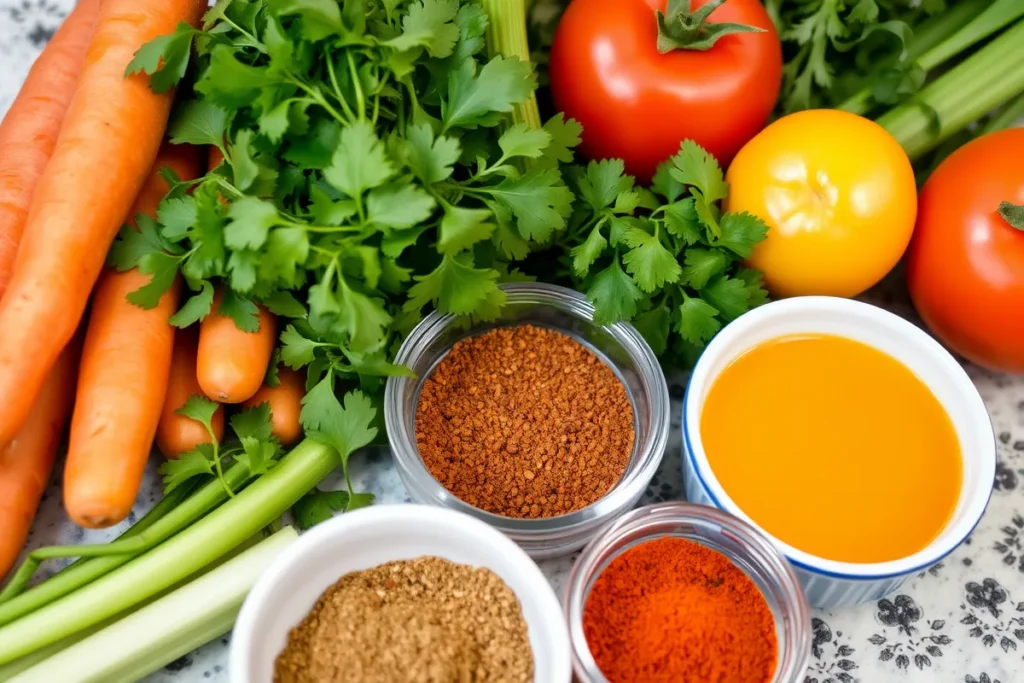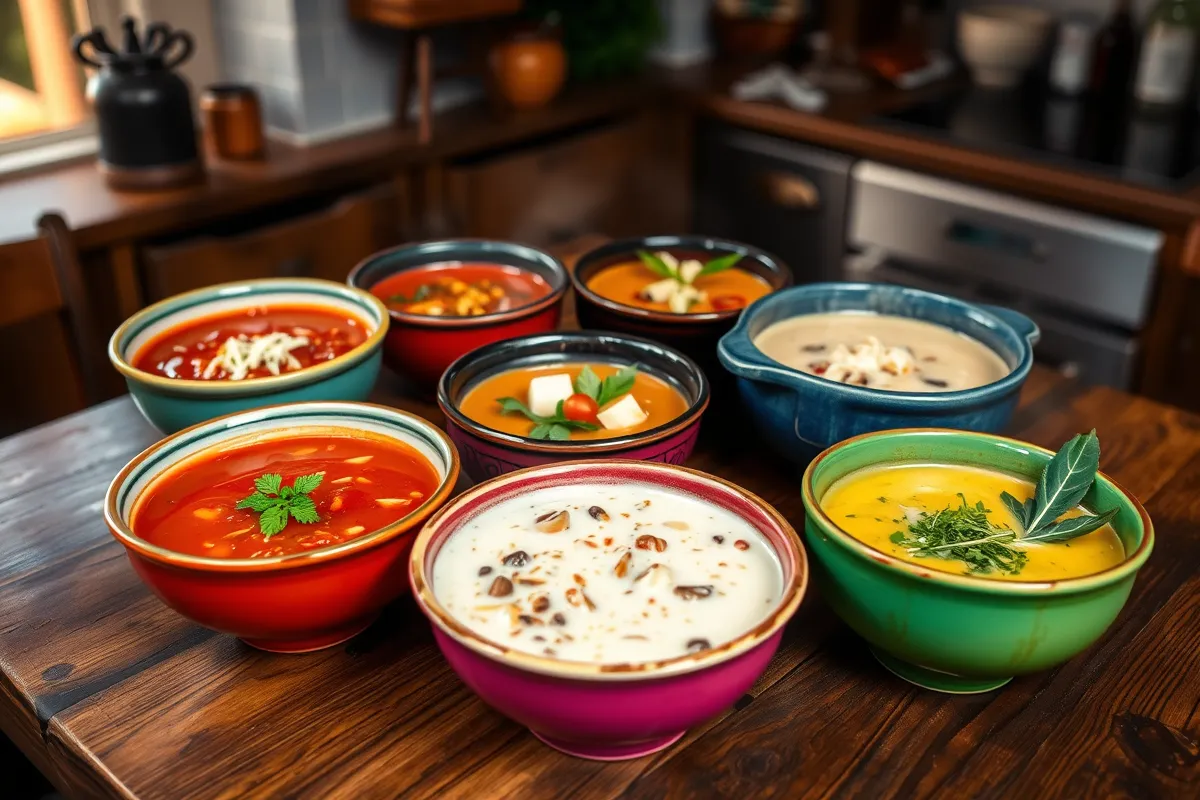Introduction
Soups are a universal comfort food, loved for their ability to bring warmth, nourishment, and incredible flavor. Across the globe, different cultures have created their own unique soups, each showcasing local ingredients and traditions. From the creamy textures of European broths to the spicy, aromatic soups of Asia, these dishes are as diverse as the people who enjoy them. And in this article wea re going to cover The Most Delicious Soups across the world.
But what makes the most delicious soups stand out? It’s the perfect blend of flavors, textures, and cultural authenticity. These soups are more than just meals; they’re culinary experiences that transport you to different parts of the world with every spoonful.
In this journey, we will uncover some of the world’s most famous soups. We’ll explore their origins, ingredients, and cultural significance. Get ready to be inspired to try these remarkable dishes and perhaps even recreate them in your own kitchen!
What Defines a Delicious Soup
When it comes to the most delicious soups, there are several key elements that make them truly stand out. Soups have the power to evoke comfort, delight the senses, and showcase a balance of flavors. But what exactly goes into creating a soup that people remember and cherish?
First, the ingredients play a crucial role. High-quality, fresh, and seasonal ingredients form the foundation of any great soup. Whether it’s the ripe tomatoes in a Gazpacho or the perfectly seasoned broth in a Vietnamese Phở, the best soups emphasize the importance of fresh produce and premium components.
Next, the preparation method contributes significantly to the flavor. Slow simmering, for example, allows the ingredients to meld together, creating a depth of flavor that cannot be rushed. Additionally, spices, herbs, and aromatics are often the secret to enhancing a soup’s taste, adding layers of complexity that elevate the dish.
Finally, cultural significance is an essential aspect. Soups are often tied to traditions and memories, making them more than just food. A bowl of soup can transport someone to their grandmother’s kitchen or a bustling street market in a foreign country. This emotional connection is what makes soups so universally loved.
Transitioning from these basics, let’s dive into the world’s most delicious soups and see what makes each one exceptional.
Top 10 Most Delicious Soups Around the World
Soups are a staple in cuisines worldwide, with each country offering its own unique and flavorful variations. Here, we explore the most delicious soups from around the globe, each one celebrated for its taste, ingredients, and cultural heritage.
Phở – Vietnam
Phở is a Vietnamese classic known for its aromatic broth and fresh ingredients. This soup features rice noodles served in a fragrant beef or chicken stock, garnished with herbs like cilantro, Thai basil, and scallions.
The secret to Phở’s depth of flavor lies in the slow simmering of bones, ginger, and spices such as star anise and cinnamon. It’s a dish that’s often enjoyed as breakfast in Vietnam, but its universal appeal makes it a favorite at any time of day.
Ramen – Japan
Japan’s Ramen is a culinary icon, offering a symphony of flavors and textures in every bowl. The base of this dish is the broth, which can be light and clear (shoyu) or rich and creamy (tonkotsu). Wheat noodles, soft-boiled eggs, and toppings like pork slices or seaweed complete this comforting soup.
Ramen is a global favorite, celebrated for its endless variety and ability to adapt to local ingredients and tastes.
Borscht – Ukraine
Borscht is a vibrant beet soup with roots in Ukrainian and Eastern European cuisine. This hearty dish typically includes beets, cabbage, potatoes, and meat, creating a rich and earthy flavor profile.
Served hot or cold, Borscht is a versatile soup often accompanied by a dollop of sour cream. Its striking color and bold taste make it a beloved dish across many countries.
Tom Yum – Thailand
Tom Yum is Thailand’s famous hot and sour soup, known for its bold, citrusy flavors. Made with lemongrass, kaffir lime leaves, chili, and shrimp, this soup is a harmonious blend of spicy, tangy, and savory.
Its refreshing yet fiery profile makes Tom Yum a favorite choice for those craving a soup with a kick.
Bouillabaisse – France
Bouillabaisse is a traditional French soup originating from the coastal city of Marseille. This luxurious seafood stew features a variety of fish, shellfish, and aromatic herbs simmered in a saffron-infused broth.
The heart of Bouillabaisse lies in its preparation. Freshly caught seafood is combined with olive oil, garlic, fennel, and tomatoes to create a flavorful base. It is traditionally served with a side of rouille, a garlicky saffron mayonnaise, spread on toasted bread. This soup represents the essence of Mediterranean cuisine.
Minestrone – Italy
Minestrone is Italy’s contribution to the world of hearty, vegetable-packed soups. Known for its versatility, this dish often includes a mix of beans, pasta, and seasonal vegetables such as zucchini, carrots, and spinach.
Minestrone’s flavor comes from its slow-cooked base of tomatoes and aromatics, with herbs like basil and oregano enhancing its taste. Whether served as a starter or a main course, it’s a nutritious and satisfying soup that highlights Italian culinary traditions.
Gazpacho – Spain
Gazpacho is a refreshing cold soup that hails from Spain, particularly the Andalusian region. Made with ripe tomatoes, cucumbers, bell peppers, and olive oil, this soup is blended to a silky consistency and served chilled.
Gazpacho’s light and tangy flavor makes it perfect for hot summer days. It’s a soup that showcases the best of Mediterranean produce and is a testament to the simplicity and elegance of Spanish cuisine.
Laksa – Malaysia and Singapore
Laksa is a beloved Southeast Asian soup that combines spicy, tangy, and creamy flavors. This dish is a marriage of Chinese and Malay culinary traditions, featuring rice noodles in a rich coconut milk-based curry broth.
Topped with shrimp, chicken, or tofu, and garnished with fresh herbs and lime, Laksa is a bowl bursting with flavor. Variations like Asam Laksa use tamarind for a tangy twist, offering a delightful regional contrast.
Harira – Morocco
Harira is a cherished Moroccan soup, traditionally served during Ramadan to break the fast. This hearty dish combines tomatoes, lentils, chickpeas, and an aromatic blend of spices like cinnamon, turmeric, and ginger.
Often enriched with small amounts of meat such as lamb or chicken, Harira is both nutritious and flavorful. It’s usually accompanied by dates and chebakia, a sesame cookie, making it a perfect meal to nourish and satisfy.
Each of these soups reflects the culture and history of its origin, showcasing the incredible diversity of the most delicious soups in the world. From spicy and tangy to creamy and comforting, these dishes have something to offer for every palate.
Common Ingredients in World-Famous Soups
What makes the most delicious soups so universally loved is their ability to transform simple ingredients into extraordinary flavors. Despite the diversity of soups worldwide, there are common elements that contribute to their taste and appeal.

Fresh Herbs and Spices
Herbs and spices are essential in enhancing the flavor of soups. Ingredients like parsley, cilantro, thyme, and bay leaves add depth and aroma to the broth. Spices such as cinnamon, cumin, and chili not only elevate the flavor but also give soups their signature regional flair. For instance, lemongrass and kaffir lime leaves define the bold taste of Thai Tom Yum, while saffron imparts luxury to French Bouillabaisse.
Quality Broth
A flavorful broth is the backbone of any great soup. Whether it’s a meat-based stock or a vegetable broth, the richness and seasoning of the liquid set the foundation for the entire dish. Slow-cooked broths, made from simmering bones, vegetables, and aromatics, are particularly prized for their complexity and depth.
Seasonal Vegetables
Vegetables bring freshness and texture to soups. Ingredients like tomatoes, onions, carrots, and celery form the base of many recipes, while seasonal additions such as squash, corn, or mushrooms highlight regional produce. In soups like Minestrone or Borscht, vegetables take center stage, showcasing their natural flavors.
Protein and Grains
Proteins, whether meat, seafood, or legumes, provide substance and richness to soups. From the clams in New England Clam Chowder to the lentils in Moroccan Harira, proteins add a satisfying element to each bite. Similarly, grains like rice or noodles, as seen in Vietnamese Phở and Malaysian Laksa, make soups heartier and more filling.
Aromatics and Acidity
Aromatics like garlic, onions, and ginger are the unsung heroes of many soups, infusing them with depth and complexity. Acidity, often added through vinegar, citrus, or fermented ingredients, balances the richness of soups and enhances their flavor. For example, the lime juice in Tom Yum gives it a refreshing tang, while tamarind adds a sour kick to Asam Laksa.
These common ingredients demonstrate the universal techniques used to create flavorful soups. Despite their differences, the world’s most delicious soups share a reliance on fresh, high-quality components to achieve their remarkable tastes.
Cultural Significance of Soups Globally
Soups are much more than just a meal; they are an integral part of cultural identities worldwide. Across continents, they have played a role in bringing communities together, symbolizing comfort, and marking important occasions.
A Reflection of Tradition
In many cultures, soups are steeped in history and tradition. Recipes are often passed down through generations, preserving family and regional culinary practices. For example, Harira is deeply tied to Moroccan Ramadan celebrations, while Borscht holds a special place in Ukrainian feasts and gatherings. These dishes are not just about flavor—they are about connecting to one’s heritage and honoring the past.
A Universal Comfort Food
Few foods can match the comforting nature of a warm bowl of soup. It’s a dish that transcends borders, offering solace during cold winters or as a remedy during illness. Minestrone, for instance, embodies Italian home-cooking comfort, while chicken soups in various forms are recognized worldwide as a soothing, healing meal.
Soups in Festive and Ritual Contexts
Soups are often central to festivals and rituals. Bouillabaisse, once considered a fisherman’s stew, is now a centerpiece at celebratory meals in Provence. Similarly, Tom Yum is a staple at Thai celebrations, showcasing the bold and vibrant flavors of the region. Whether it’s breaking the fast with Harira or sharing a pot of Ramen with loved ones, soups often symbolize togetherness and joy.
Soups as Culinary Ambassadors
As global cuisines intermingle, soups have become ambassadors of their respective cultures. A bowl of Laksa, served in an international restaurant, introduces diners to the fusion of Chinese and Malay flavors. Likewise, Gazpacho represents the Mediterranean’s simplicity and reliance on fresh produce. Through soups, people experience the world’s diverse culinary heritage.
Soups, with their rich flavors and deep cultural roots, continue to bridge gaps and bring people together. They remind us of our shared humanity while celebrating the uniqueness of each culture’s culinary expression.
Tips for Making Delicious Soups at Home
Creating the most delicious soups in your own kitchen is easier than you might think. With the right techniques and a bit of creativity, you can replicate the rich flavors and comforting textures of world-famous soups. Here are some essential tips to help you master the art of soup-making.
Start with a Strong Base
The foundation of any great soup is a flavorful broth. Whether it’s chicken, beef, vegetable, or seafood-based, a homemade broth will elevate your soup far beyond store-bought alternatives. Simmer bones, fresh vegetables, and aromatic herbs for several hours to extract maximum flavor.
Use Fresh, Quality Ingredients
The quality of your ingredients can make or break your soup. Opt for fresh vegetables, herbs, and proteins whenever possible. Seasonal produce is particularly ideal, as it is often at its peak flavor and nutrient content.
Don’t Rush the Process
The most flavorful soups often require time. Slow cooking allows ingredients to release their essence and combine harmoniously. For example, simmering spices and aromatics in Tom Yum or a Bouillabaisse creates layers of complexity that cannot be achieved with quick cooking methods.
Balance Flavors
Balancing flavors is key to creating a memorable soup. Pay attention to the balance between salty, sweet, sour, and spicy elements. For example, a squeeze of lime can brighten up a rich broth, while a dash of sugar can offset acidity.
Experiment with Garnishes
Garnishes are the finishing touch that can elevate your soup’s presentation and flavor. Fresh herbs, a drizzle of olive oil, a sprinkle of cheese, or crispy croutons add texture and visual appeal. Phở, for instance, is often topped with fresh basil, bean sprouts, and lime wedges for added freshness.
Make It Your Own
While traditional recipes are a great starting point, don’t be afraid to adapt them to your taste or dietary needs. Substitute ingredients, experiment with spices, or combine elements from different cuisines to create a soup that’s uniquely yours.
By following these tips, you can bring the magic of the most delicious soups in the world to your home kitchen, one flavorful bowl at a time.
Conclusion
Soups are a testament to the beauty of culinary diversity. From the spicy Tom Yum of Thailand to the creamy Clam Chowder of New England, the most delicious soups in the world offer a journey through flavors, traditions, and cultures. These dishes are more than just food; they are stories passed down through generations, capturing the essence of local ingredients and cultural pride.
As we’ve explored, the ingredients, preparation techniques, and cultural significance all contribute to what makes a soup truly unforgettable. Whether you’re savoring a bowl of hearty Minestrone or enjoying the tangy freshness of Gazpacho, each soup has its own unique charm.
By experimenting with fresh ingredients and embracing traditional recipes, you can bring these remarkable soups into your own kitchen. So, grab your ladle, explore the possibilities, and discover the joy that a simple bowl of soup can bring to your table.
You can also Find some of the soups we covered earlier in these links:
1 / How to Make the Perfect Cowboy Soup: A Hearty and Delicious Recipe
2 / 4-Ingredient Potato Soup: Quick, Easy, and Delicious

